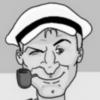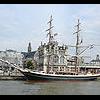-
Posts
1,267 -
Joined
-
Last visited
Reputation Activity
-
 AnobiumPunctatum reacted to Jaekon Lee in HMS Alert 1777 by Jaekon Lee - 1/64
AnobiumPunctatum reacted to Jaekon Lee in HMS Alert 1777 by Jaekon Lee - 1/64
Many thanks Nils for your compliment.
Small update today. Lower thick stuffs are added with steam bent long strakes. She becomes stronger day by day.
-
 AnobiumPunctatum got a reaction from Jaekon Lee in HMS Alert 1777 by Jaekon Lee - 1/64
AnobiumPunctatum got a reaction from Jaekon Lee in HMS Alert 1777 by Jaekon Lee - 1/64
Lee,
as I've written earlier I think that the frames design in the AotS is wrong. The shifted top timbers are only a fix for this design. Also the positions of the gun ports don't match the position of the original drawing.
I could only find double frames for cutters. If I read Allans comment he confirmed what I think.
There exist no contemporary drawing of the framing design for the Rattlesnake class. I've drawn a simplified framing but will now try to make a new reconstruction of the framing to check if my ideas are possible.
-
 AnobiumPunctatum reacted to Jaekon Lee in HMS Alert 1777 by Jaekon Lee - 1/64
AnobiumPunctatum reacted to Jaekon Lee in HMS Alert 1777 by Jaekon Lee - 1/64
Keelson and limber strake
Small update by joining keelson and limber strake but, the structure became a little stronger one.
-
 AnobiumPunctatum reacted to Chuck in HM Cutter Cheerful 1806 by Chuck - FINISHED - 1:48 scale - kit prototype
AnobiumPunctatum reacted to Chuck in HM Cutter Cheerful 1806 by Chuck - FINISHED - 1:48 scale - kit prototype
The Square tuck....Thank goodness this isnt a real POF project. Here is the simplified version.
The photo below shows the first beam added which to create teh base for the stern post. It runs down the center of the square tuck so I can glue the stern post on later. It is 1/8" thick and 7/32" wide. The same width as the stern post
The same photo below shows the second timber....how I took a wider piece that was 1/8" thick. I shaped it so the seam between the lower counter and this timber was very tight. Then I measured and marked it so it would be 1/8" wide as well. This will of course be repeated on the other side once it is planked.
The finished timber below.
Then it was time to create the side piece which will finish the square tuck frame....this was the hardest piece but not that difficult at all. I just took a larger 1/8" thick piece of boxwood and shaped it to fit tightly against the two timbers I just just completed. I tried to get real tight seams. At the same time, it hangs off the side of the hull. Then I traced the shape of the hull against the back of this piece.
Heres what the tracing looks like. The piece was cut to shape on the scroll saw.
Then, this piece was temporarily glued back in position with just a small dot of CA. This was done because it will need to be removed after it is faired with the hull planking. See below. And as done before, I drew another line to establish a 1/8" wide finished timber. This was cut out and glued into position finishing the frame for the square tuck on this side of the hull.
Here is what it looks like.
Finally....it was planked inside with vertical planks the same width as the hull planking. Tarred seams were simulated. I was very careful to get very tight seams. In actual practice these planks would be normal thickness and the ends resting in a rabbet along the edges of the square tuck frame.
In my case though, I just faked it using planking that was actually 1/8" thick which is the same thickness as the frame. It all worked out in the end. I am quite pleased with the results as this is normally a really tough detail to model convincingly. Now to touch up the red paint on the counter or maybe its just best to wait till the planking is all done.
I can now start planking the last belt on the starboard side.
-
 AnobiumPunctatum got a reaction from wangshuoliurui in HMS Triton 1773 by jaerschen - 1/48 - POF
AnobiumPunctatum got a reaction from wangshuoliurui in HMS Triton 1773 by jaerschen - 1/48 - POF
Nice fix, Jürgen
-
 AnobiumPunctatum got a reaction from AntonyUK in HM Cutter Cheerful 1806 by Chuck - FINISHED - 1:48 scale - kit prototype
AnobiumPunctatum got a reaction from AntonyUK in HM Cutter Cheerful 1806 by Chuck - FINISHED - 1:48 scale - kit prototype
Tony,
there is not really a problem. I buy my timber at a supplier in Germany, who cuts it to every size with a precision of 1/10mm. I think that this is precise enough for a scratch build model. http://www.modellbau-holzleisten.de/
-
 AnobiumPunctatum reacted to Chuck in HM Cutter Cheerful 1806 by Chuck - FINISHED - 1:48 scale - kit prototype
AnobiumPunctatum reacted to Chuck in HM Cutter Cheerful 1806 by Chuck - FINISHED - 1:48 scale - kit prototype
Jan
The square tuck frame should be rabbeted so the hull planking and square tuck planking has the the butt ends protected from the elements. The lower counter planking has its butt ends protected by the fashion pieces. The strip between the lower counter and the square tuck is just a fancy molding strip and cosmetic.
I have about 40 pictures of this model from every conceivable angle. Just havent had the time to reduce them so I can post them.
But if you want to see any particular area let me know and I will reduce and post those....If you click on the picture above in that post it gets really big...you can see that detail..The fancy molding strip is placed too low however on that model in my opinion. The frame for the square tuck needs to be a consistent width all of the way around to look good. Thats the hard part but in a few steps it can be done without incident.
Chuck
-
 AnobiumPunctatum reacted to Chuck in HM Cutter Cheerful 1806 by Chuck - FINISHED - 1:48 scale - kit prototype
AnobiumPunctatum reacted to Chuck in HM Cutter Cheerful 1806 by Chuck - FINISHED - 1:48 scale - kit prototype
I will do that on the next update.....
Christian...It is the square tuck that you are seeing. Its actually curved slightly to follow the counter. So you see it as a triangle on the plan. Thats what I am going to start next. Shouldnt be long before another update with that. See what it looks like on the Rogers Collection cutter model.
Chuck
-
 AnobiumPunctatum got a reaction from jaerschen in HMS Triton 1773 by jaerschen - 1/48 - POF
AnobiumPunctatum got a reaction from jaerschen in HMS Triton 1773 by jaerschen - 1/48 - POF
Jürgen,
what kind of timber do you use for the planking? The contrast to the darker swiss pear looks really great
-
 AnobiumPunctatum reacted to tadheus in La Salamandre by tadheus - 1:24
AnobiumPunctatum reacted to tadheus in La Salamandre by tadheus - 1:24
Continuation.
6mm X 15 mm
The beginning of the relationship is available at this address:
http://5500.forumact...ndre-1-24#66516
Regards, Paul
-
 AnobiumPunctatum got a reaction from Jaekon Lee in HMS Alert 1777 by Jaekon Lee - 1/64
AnobiumPunctatum got a reaction from Jaekon Lee in HMS Alert 1777 by Jaekon Lee - 1/64
Lee,
last year as I started with the project, I had the same idea. But I had problems to match the dimensions he has given in the first part of the book with the drawings. At this point I started to use a simplified frame model. Then I started my build but was not happy.
His line drawing differs from the original drawing which you can find on the NMM Homepage. And I couldn't find the reasons.
In September I bought the original drawing and started again ... the rest of the story you know. Meanwhile it makes a lot of fun to search and compare the different original drawings. I think I will do the same steps on the next models I like to build also.
There is also nothing wrong with your approach. I will follow your log with great interest.
-
 AnobiumPunctatum reacted to rtropp in Triton Cross Section 1:48 RichardT
AnobiumPunctatum reacted to rtropp in Triton Cross Section 1:48 RichardT
I thought it was about time for an update. As I explained in my Syren thread, I am learning how to use tools and that is considerably extending the amount of time it takes to perform even simple tasks. But, I am sure having fun.
In order to better work on the frame parts I made the following jig for my micro mill.
It works great at keeping the room almost sawdust free.
Also wanted to increase safety on the table saw
And this not only increases safety but also increases the precision of the cuts.
Ok, here is where I am to date
This was next sanded using my proxxon disk sander and the new drum sander. Of course I forgot to take a picture of it finished :-)
I know the lines are already colored blue but wanted to make sure I could identify it if the sanding took out the lines... it didn't.
I had to rework a few of the frames. Some were skills issues. A a couple seemed to be poor basswood. I bought some 3/16 from hobby lobby and a couple of the pieces felt wrong... spongy, but I tried them anyway.
I am practicing this first build in basswood because it is cheap and available. I have some pear and boxwood planks coming that I can size on my "soon to arrive" Byrnes Thickness Sander.
I may just go ahead and consider the basswood frames as skill building and if it all fits nicely on the keel go back and rebuild using the boxwood or pear. Not sure yet.
I did not think I would want to have two builds going at once, but it is nice to take breaks from one to work on the other. Kinda re-energizes you.
Oh, by the way, is there a top down plan for the Cross section? I'd like to put it down and use it to guide the assembly. I did not see one in the downloads.
and so it goes...
Richard
-
 AnobiumPunctatum reacted to Jaekon Lee in HMS Alert 1777 by Jaekon Lee - 1/64
AnobiumPunctatum reacted to Jaekon Lee in HMS Alert 1777 by Jaekon Lee - 1/64
Forward cant frame and hawse pieces.
After all the square frames were joined with glue to the keel assembly, forward cant half frames and hawse pieces were glued. It was also not clear, there is no sign of scoring or mortising on the apron at the plan of Goodwin, I glued cant frames directly on the forward apron. The feet of them were matched to just above the rabbet line. Now, I'm going to aft.
-
 AnobiumPunctatum got a reaction from Chasseur in Licorne 1755 by mtaylor - 3/16" scale - French Frigate - from Hahn plans - Version 2.0 - TERMINATED
AnobiumPunctatum got a reaction from Chasseur in Licorne 1755 by mtaylor - 3/16" scale - French Frigate - from Hahn plans - Version 2.0 - TERMINATED
Mark,
I wish yo a lot of fun with your beast. I'll follow your log with great interest.
-
 AnobiumPunctatum got a reaction from mtaylor in HMS Alert 1777 by Jaekon Lee - 1/64
AnobiumPunctatum got a reaction from mtaylor in HMS Alert 1777 by Jaekon Lee - 1/64
Lee,
last year as I started with the project, I had the same idea. But I had problems to match the dimensions he has given in the first part of the book with the drawings. At this point I started to use a simplified frame model. Then I started my build but was not happy.
His line drawing differs from the original drawing which you can find on the NMM Homepage. And I couldn't find the reasons.
In September I bought the original drawing and started again ... the rest of the story you know. Meanwhile it makes a lot of fun to search and compare the different original drawings. I think I will do the same steps on the next models I like to build also.
There is also nothing wrong with your approach. I will follow your log with great interest.
-
 AnobiumPunctatum reacted to Dan Vadas in HMS Vulture 1776 by Dan Vadas - FINISHED - 1:48 scale - 16-gun Swan-class sloop from TFFM plans
AnobiumPunctatum reacted to Dan Vadas in HMS Vulture 1776 by Dan Vadas - FINISHED - 1:48 scale - 16-gun Swan-class sloop from TFFM plans
I was unhappy about the thread color and the stark contrast for the crowsfeet, so I'm re-doing them with black line :
This is not entirely accurate, as to the best of my knowledge they weren't tarred, but the visual aspect is far better.
Danny
-
 AnobiumPunctatum reacted to jaerschen in HMS Triton 1773 by jaerschen - 1/48 - POF
AnobiumPunctatum reacted to jaerschen in HMS Triton 1773 by jaerschen - 1/48 - POF
Hello, the next step is done and the Main Wale is fitted.
I had I little mistake nearing completion. The following photo should be a little help to declare it.
For fitting the last ledge of the Main Wale it was necessary to sanding the outside of the side counter timber at starboard side (blue arrow). But there wasn't enough material, the part was to small at this point (yellow x) . I had to many material removed at the inner side (red arrow).
The exchange of the part seems like too much effort to me. So I decided to glue a piece of wood to the counter and sanded it down. I believe that must be alright on the finished model.
And now some photos of the Main Wale. It's still to do a bit sanding on the port side.
-
 AnobiumPunctatum reacted to Jaekon Lee in HMS Alert 1777 by Jaekon Lee - 1/64
AnobiumPunctatum reacted to Jaekon Lee in HMS Alert 1777 by Jaekon Lee - 1/64
Square frames
All the parts of frame were cut out from pear boards of three different thickness and glued to the square frames. After glued joints dried, all the frames were roughly trimmed and beveled to the final shape. Smoothing the inner and outer surfaces will be done after they are joined with keel.
As shown on Goodwin's framing plans, most of 2nd futtocks and top timbers are shifted from lower timbers. I don't know this unique design of frame is the same as that of original ship. Though building frame of this design seems to be very tough, it is very attractive point especially for this small scale.
Following pics show the progress of work. In these pics, frames are not glued yet but inserted to rising wood of the keel assembly.
LEE
-
 AnobiumPunctatum reacted to Chuck in HM Cutter Cheerful 1806 by Chuck - FINISHED - 1:48 scale - kit prototype
AnobiumPunctatum reacted to Chuck in HM Cutter Cheerful 1806 by Chuck - FINISHED - 1:48 scale - kit prototype
I added the first two strakes below the wales. This was to get the drop plank out of the way. The drop plank was shaped from a piece of card stock first just to get the hang of it. After I was satisfied that it fit OK I cut the real ones from wide stock the same thickness as the planking. They were pre shaped as you can see. You can also see my pencil on the edge to simulate the tarred seams. Now I will line off the remainder of the hull into two belts and finish the planking. I also painted the first of many layers of red paint on the counter at the stern.
Chuck
-
 AnobiumPunctatum reacted to tlevine in HMS Atalanta 1775 by tlevine - FINISHED - 1:48 scale - from TFFM plans
AnobiumPunctatum reacted to tlevine in HMS Atalanta 1775 by tlevine - FINISHED - 1:48 scale - from TFFM plans
I have decided to use a finish that will not yellow the holly. In TFFM David mentions a solvent-based sealer for his finish. For those of you who own his Comet book or have seen the photos, that is the look I am trying to achieve. The bottle of solvent-based sanding sealer I have was quite a few years old so I purchased some from Midwest Models, as well as a bottle of flat finish. I have not decided whether to stick with just the sealer or put a coat of finish on as well. The pictures are taken after two coats of sealer, the first sanded down to 320 grit and the second sanded to 400. Later this week I will test applying a coat of the finish on some scrap wood. One of the nice things about the sealer is that the drying time is very fast but as this is solvent based the smell is pretty strong. Unlike a oil based finish, the odor dissipates quickly.
-
 AnobiumPunctatum reacted to tlevine in HMS Atalanta 1775 by tlevine - FINISHED - 1:48 scale - from TFFM plans
AnobiumPunctatum reacted to tlevine in HMS Atalanta 1775 by tlevine - FINISHED - 1:48 scale - from TFFM plans
Thanks, everyone for the comments and the likes. I have finished the treenails. I estimate that the whole process consumed about 25 hours of my life. So my ugly duckling is now in the process of becoming a swan (class). Sorry, couldn't help it. I removed the hull from the board for the sanding process. I find it easier to sand a curved object while holding it in my lap. This gives me easier access to the various rabbets and the intersection with the wing transom. In the process, despite using masking tape, the main wale has gotten fairly scuffed up and will require another coat of paint. In the pictures the hull has been sanded down with 100 grit. The treenails are hard to see because no finish has been applied yet.
-
 AnobiumPunctatum got a reaction from Jeronimo in LE BONHOMME RICHARD by Jeronimo - FINISHED
AnobiumPunctatum got a reaction from Jeronimo in LE BONHOMME RICHARD by Jeronimo - FINISHED
Karl,
as allways absolut fantastic. In a very far future I hope I can build my models nearly accurate than you.
-
 AnobiumPunctatum got a reaction from Jeronimo in LE BONHOMME RICHARD by Jeronimo - FINISHED
AnobiumPunctatum got a reaction from Jeronimo in LE BONHOMME RICHARD by Jeronimo - FINISHED
Your anchors are looking really realistic.
-
 AnobiumPunctatum got a reaction from Jeronimo in LE BONHOMME RICHARD by Jeronimo - FINISHED
AnobiumPunctatum got a reaction from Jeronimo in LE BONHOMME RICHARD by Jeronimo - FINISHED
Karl,
your model is really a reference for me and perhaps for other model builders. The accuracy in every detail of your model is absolut extraordinary. I like sitting in front of my monitor and watch the deatils.
-
 AnobiumPunctatum got a reaction from Jeronimo in LE BONHOMME RICHARD by Jeronimo - FINISHED
AnobiumPunctatum got a reaction from Jeronimo in LE BONHOMME RICHARD by Jeronimo - FINISHED
Moin Karl,
I am very happ to see your build log again.









